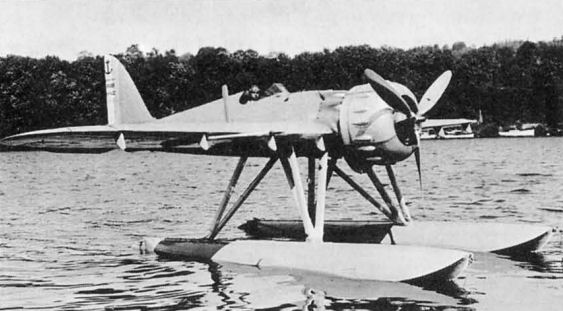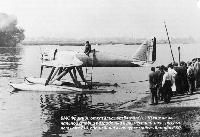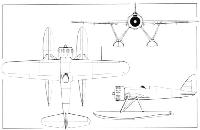Bernard Н.52
Bernard Н.52 представлял собой одноместный гидросамолет-истребитель со среднерасположенным свободнонесущим крылом и открытой кабиной пилота. Первый полет самолет совершил 16 июня 1933 года. Bernard Н.52 был построен в соответствии с требованиями, объявленными ВМС Франции, и создавался с использованием наработок по модели Bernard 260, получив от последнего хвостовое оперение, крыло и заднюю часть фюзеляжа. Машина имела цельнометаллическую конструкцию, закрылки Хендли Пейджа, как и у Bernard 260, оснащалась двухпоплавковым шасси, а центральная часть ее фюзеляжа была интегрирована с крылом. Второй экземпляр самолета испытан в 1934 году, но серийного выпуска не последовало.
ТАКТИКО-ТЕХНИЧЕСКИЕ ХАРАКТЕРИСТИКИ
Bernard Н.52
Тип: одноместный гидросамолет-истребитель
Силовая установка: один звездообразный двигатель Gnome-Rhone 9Kdrs Mistral мощностью 500 л. с. (373 к8т)
Летные характеристики: максимальная скорость на высоте 4000 м - 329 км/ч; подъем на высоту 4000 м - за 9 мин; дальность полета 600 км
Масса: пустого 1480 кг; максимальная взлетная 1888 кг
Размеры: размах крыла 11,30 м; длина 9,30 м; высота 4,27 м; площадь крыла 18,20 м:
Вооружение: два 7,5-мм пулемета Dame на неподвижных передних установках под крылом
Показать полностьюShow all
Bernard Н.110
Будучи схожим с Н.52, Bernard Н.110 представлял собой одноместный гидросамолет-истребитель, оснащенный более мощным двигателем Hispano-Suiza 9Vbs (710 л. с). Имея в основном металлическую конструкцию, он отличался от своего предшественника тканевой обшивкой крыла. Когда приступили к созданию самолета, компания "Bernard" находилась в процессе ликвидации, поэтому модель Н.110 строилась уже на заводе компании "Societe Schreck". Испытания нового самолета начались в июне 1935 года, но вскоре были прекращены из-за финансовых проблем компании "Bernard", после чего дальнейшие работы по проекту были прекращены.
ТАКТИКО-ТЕХНИЧЕСКИЕ ХАРАКТЕРИСТИКИ
Bernard Н.110
Тип: одноместный гидросамолет-истребитель
Силовая установка: один звездообразный двигатель Hispano-Suiza 9Vbs мощностью 710 л. с. (529 кВт)
Летные характеристики: максимальная скорость на высоте 2500 м - 330 км/ч
Масса: максимальная взлетная 1900 кг
Размеры: размах крыла 11,60 м; длина 9,30 м; площадь крыла 19,00 MJ
Вооружение: два 7,5-мм неподвижных пулемета Darne на передней кромке крыла
Показать полностьюShow all
Flight, March 1934
The Bernard 52 C I
DESIGNED primarily as a twin-float seaplane fighter, the Bernard 52 C I is rather similar, in general design, to the types 74 and 75 single-seater fighters which were entered for the recent French "Concours des Avions de Chasse." As may be seen from the G.A. drawings, the aircraft is a mid-wing cantilever monoplane with divided float undercarriage. This type of undercarriage was chosen in order to allow a bomb to be carried centrally under the fuselage. (Which might indicate that the machine may be used for "dive bombing," a method of attack for which single-seater fighters seem to be coming increasingly popular, e.g., the American Curtiss and Boeing fleet fighters.) Fittings for catapult work are provided.
Duralumin is the chief material used for the construction of this machine. Handley Page slots are fitted along the greater part of the leading edge of the wing, and trailing edge flaps of high aspect ratio are provided for a low landing speed. In connection with the Handley Page slots, we would remind the reader that the French Air Ministry recently concluded an agreement with Handley Page, Ltd., whereby the French Air Force and the French manufacturers may fit these slots to their aircraft. One other interesting feature is that a portion of the fuselage and the main structure of the wing are built integrally, as in some previous Bernard fighters.
Sheet duralumin covering is used for the fuselage, which is of oval section. The section of the fin is unusually thick. At present, a Gnome-Rhone K-9 engine of 500 h.p. is fitted, enclosed in a N.A.C.A. type cowling, but a later version of this engine, which gives 600 h.p. with no increase in weight, may be substituted. The performance figures given in the table apply to the aircraft fitted with the older type engine.
BERNARD 52 C I.
Span 37-73 ft. (11,5 m)
Length 24-44 ft. (8,67 m)
Height 14-26 ft. (4,35 m)
Wing Area 195-91 sq.ft. (18,2m2)
Weight loaded 4,019 lb. (1 827 kg)
Speed at 11,483 ft. (3 500 m) 205 m.p.h. (330 km/h.)
Ceiling 27,887 ft. (8 500 m)
Climb to 16,404 ft. (5 000 m) 7 min.
Stalling speed 61 m.p.h. (98 km/h.)
Показать полностьюShow all
Flight, November 1934
THE FOURTEENTH PARIS AERO SHOW
THE EXHIBITS DESCRIBED
Marine Aircraft
<...>
In the French Air Ministry section the most interesting seaplane exhibit is the tiny Bernard H.52 C.1. This is a single-seater seaplane fighter, powered by a 500 h.p. Gnome-Rhone 9 Krsd supercharged air-cooled engine. The machine has been designed with a view to transforming it into a landplane fighter. The speed claimed for it is 280 km.p.h. (174 m.p.h.) at ground level, and 320 km.p.h. (198 m.p.h.) at 13,000 ft. The machine is of all-metal construction.
<...>
Показать полностьюShow all






